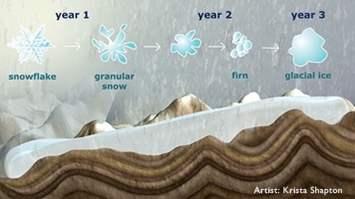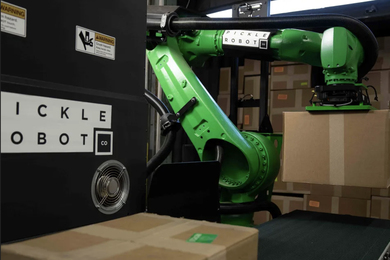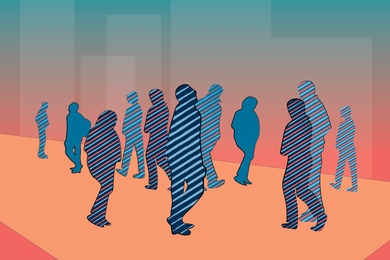"Art is a real job." Credit this aphorism to Violeta Ivanova, a senior educational technology consultant in MIT's Office of Educational Innovation and Technology (OEIT).
Ivanova is the mover and shaker behind ARTEMiS (short for "ART for Engineering, Mathematics and Science"), an initiative in educational visualization launched last summer. In her work as an OEIT consultant, Ivanova has talked with many MIT faculty who are interested in computer visualization as a teaching tool. But it's not enough to have high-end computers and software. "These programs don't magically create beautiful visualizations," Ivanova says. "You need the people with the skills."
And so ARTEMiS was born. It combines the principles of visual communication with the tools of modern computer graphics to enhance teaching and learning in science and technology. In the project's first year, Ivanova and artist/animator Krista Shapton have built a portfolio that showcases the power of computer graphics to illustrate basic science and math concepts.
Their innovative portfolio includes
In choosing these projects, Ivanova has focused on fundamental concepts that can be visually demonstrated in a compelling way, beyond what words alone can portray. For example, subject matter that involves the interaction of shapes plays to visualization's strengths.
Ivanova also notes that "MIT is very open to the world," including engagement with K-12 education. So ARTEMiS projects are tailored to have broad educational appeal, viewable as part of classes or online on their own.
Tools of the trade
The ARTEMiS Team is Mac-based, working on two top-of-the-line iMacs with high-end graphics capability, including lots of RAM for rendering complex shapes, textures, lighting and shading.
The software in their shop includes Maya, After Effects, and the Unity3D game engine:
In ARTEMiS's first year, Ivanova concentrated on building a portfolio to showcase the skills needed to produce compelling visualizations. As the initiative's second year begins, Ivanova has set her sights on a few new goals.
She plans to redesign the ARTEMiS website, so that it's easier for visitors to learn more about how visualizations are created. Several galleries will be available from the homepage, and blog content by the ARTEMiS team will highlight the creative process and use of software. The redesigned website will be go live sometime this summer.
Ivanova also plans to build a roster of top-notch animators that OEIT can recommend, so that interested faculty can move forward with their own visualization projects. The ARTEMiS Team will be available for consultation and can be reached via email.
Ivanova is the mover and shaker behind ARTEMiS (short for "ART for Engineering, Mathematics and Science"), an initiative in educational visualization launched last summer. In her work as an OEIT consultant, Ivanova has talked with many MIT faculty who are interested in computer visualization as a teaching tool. But it's not enough to have high-end computers and software. "These programs don't magically create beautiful visualizations," Ivanova says. "You need the people with the skills."
And so ARTEMiS was born. It combines the principles of visual communication with the tools of modern computer graphics to enhance teaching and learning in science and technology. In the project's first year, Ivanova and artist/animator Krista Shapton have built a portfolio that showcases the power of computer graphics to illustrate basic science and math concepts.
Their innovative portfolio includes
- Slope. This animated film of a ski jumper illustrates the concept of slope for a K-12 audience.
- Glacial Structures. In this animation viewers observe how glaciers shape mountain terrains into various geologic structures.
- Gravity. This 15-minute video is part of series that covers pivotal scientific concepts. A collaboration between MIT and the Singapore University of Technology and Design, it features 2-D animation by Shapton.
In choosing these projects, Ivanova has focused on fundamental concepts that can be visually demonstrated in a compelling way, beyond what words alone can portray. For example, subject matter that involves the interaction of shapes plays to visualization's strengths.
Ivanova also notes that "MIT is very open to the world," including engagement with K-12 education. So ARTEMiS projects are tailored to have broad educational appeal, viewable as part of classes or online on their own.
Tools of the trade
The ARTEMiS Team is Mac-based, working on two top-of-the-line iMacs with high-end graphics capability, including lots of RAM for rendering complex shapes, textures, lighting and shading.
The software in their shop includes Maya, After Effects, and the Unity3D game engine:
- Maya. From AutoDesk, Maya is the industry-standard 3-D modeling package for Macintoshes. It mimics cinematography in the real world, with "cameras" stationed at different angles. You can create 3-D geometries, materials, lights and cameras, and animate changes over time for any of them. Once you create a 3-D story, you can export it as a movie and bring it into After Effects to mix with other elements.
- After Effects. This Adobe package does double duty as a 2-D animation program and a compositing tool. You can animate 2-D shapes and textures and also bring in media from other sources — 3-D animation from Maya, video that's been edited in Final Cut Pro, images from Illustrator or Photoshop — to build a composite animation. Before exporting this as a QuickTime file, you can also add titles and music.
- Unity3D. Game engines create 3-D media that end users can interact with, whether they are played for entertainment or to explore scientific concepts. These interactive modules provide "real-time rendering," because what you see is based on what you do with the controls (e.g., using your mouse to turn an object or zoom in and out).
In ARTEMiS's first year, Ivanova concentrated on building a portfolio to showcase the skills needed to produce compelling visualizations. As the initiative's second year begins, Ivanova has set her sights on a few new goals.
She plans to redesign the ARTEMiS website, so that it's easier for visitors to learn more about how visualizations are created. Several galleries will be available from the homepage, and blog content by the ARTEMiS team will highlight the creative process and use of software. The redesigned website will be go live sometime this summer.
Ivanova also plans to build a roster of top-notch animators that OEIT can recommend, so that interested faculty can move forward with their own visualization projects. The ARTEMiS Team will be available for consultation and can be reached via email.






